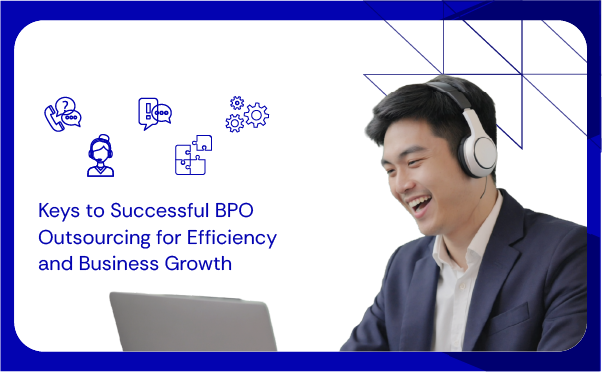In BPO outsourcing, you delegate specific business functions, such as customer service, finance, or IT, to external service providers. This strategy lets you reduce costs, access specialised expertise, and focus on core operations. BPO can be offshore, nearshore, or domestic.
It’s 4 a.m. in the US. You’re asleep! But halfway across the world, your customer support team in the Philippines is answering customer support tickets. In Eastern Europe, your development partner is pushing new code. Meanwhile, in India, your finance team has already processed payments and updated invoices before you even pour your first cup of coffee.
But, how is all this possible? Probably, that’s the magic of BPO outsourcing! It means outsourcing back office operations to teams in domestic or foreign countries. This allows your business to run 24/7 without hiring a night shift. It also reduces costs by tapping into skilled labour in countries where wages are lower.
When done right, BPO outsourcing turns your business into a global operation where your operations can run around the clock!
So, want to enjoy its benefits? In this article, we will first understand what BPO outsourcing is, its latest trends, and some of its major benefits. Next, we will learn the latest BPO outsourcing strategies and how you can do smart BPO vendor management for maximum results.
What is BPO Outsourcing?

In Business Process Outsourcing (BPO), you hire another company to handle specific business functions instead of managing them in-house. Unlike hiring a freelancer for a one-time task, in BPO, you outsource entire functions like marketing, accounting, or customer service to a specialized provider.
Now, please note that there are two main types of BPO outsourcing functions:
| Back-Office BPO | Front-Office BPO |
In this type, you outsource tasks that do not involve direct customer interaction, such as:
|
Here, you outsource customer-facing functions like:
|
Furthermore, there are also three types of BPO outsourcing based on location:
| Offshore BPO Outsourcing | Nearshore BPO Outsourcing | Domestic (Onshore) BPO Outsourcing |
| You hire a company in another country, such as a U.S. company outsourcing to the Philippines.
|
You hire a company in a nearby country, such as a U.S. company outsourcing customer support to a Canadian agency. | You hire a company within the same country. |
The Latest BPO Outsourcing Trends

By the end of 2025, the global BPO outsourcing market is estimated to reach $328.4 billion. And, by 2032, it is expected to reach $544.8 billion. This popularity is primarily because of cost reduction. For example, studies show that businesses enjoy about 27.2% average cost savings by outsourcing HR functions.
Let’s gain more clarity and check out some other interesting BPO outsourcing trends:
A) What are the Key BPO Outsourcing Regions?
- The Asia Pacific region is the largest BPO outsourcing market.
- It generates $80 billion in revenue.
- India leads with $38.9 billion and is followed by:
- The Philippines, with $26.3 billion
- China, with $10.2 billion
B) Why is BPO Outsourcing Gaining Popularity?
- For about 70% of companies, cost reduction is the main reason for BPO outsourcing.
- 65% of companies say BPO outsourcing allows them to focus on core business functions.
- BPO adoption is increasing due to new technologies like:
- Robotic process automation (RPA)
- Artificial intelligence (AI)
- Cloud systems
C) What’s Outsourced the Most?
A recent study found these functions are the most outsourced:
| Business Function | Percentage of Small Businesses Outsourcing |
| Accounting and IT | 37% |
| Digital Marketing | 34% |
| Development | 28% |
| Human Resources | 24% |
| Customer Support | 24% |
However, a recent study by Gartner estimated that by the end of 2025, about 60% of finance and accounting outsourcing contracts may not be renewed due to “automation”.
5 Major Benefits of BPO Outsourcing

Studies show that about 37% of small businesses outsource at least one business process! But why? That’s largely because of these major benefits of BPO outsourcing:
1. Focus on What You Do Best
By outsourcing non-core tasks (like HR or marketing), you allow your in-house team to concentrate on the main areas of your business. As a result, they can dedicate more time to strategic tasks and improve product quality.
Ultimately, this leads to:
- Higher productivity
- Better customer service
- Increased revenue
2. Access the Latest Tech
Most modern BPO companies, like Atidiv, often invest in advanced technologies specific to their services. Through BPO outsourcing, you can use these cutting-edge tools without having to buy or maintain them yourself.
3. Tap into Expert Talent
BPO providers hire skilled professionals. They have extensive experience in areas like:
- Finance
- IT
- Customer service
Through BPO outsourcing, you gain access to this expertise without the cost of full-time hires.
4. Cut Costs Without Compromising Quality
Mostly, BPO companies are based in countries with lower labour costs, such as India and the Philippines. They pass these savings to you! This lets you reduce expenses in areas like:
- Payroll
- Office space
- Software licenses
5. Gain a Competitive Edge
Specialised BPO companies are experts in their fields. For example,
- An outsourced IT provider may have stronger data security measures than your in-house team. This reduces the risk of cyberattacks.
- A customer experience specialist, like Atidiv, has trained staff that can easily handle huge ticket volumes in a minimum resolution time. This significantly improves CX.
Such expertise lets your business operate more efficiently as you reduce the risk of costly errors and compliance issues.
6 Popular BPO Outsourcing Strategies to Adopt in 2025

BPO outsourcing leads to cost reduction and value creation. But coordinating teams across different time zones and cultures is challenging! There are several factors that can impact your workflows, such as:
- Communication delays
- Language barriers
- Cultural differences
To manage this, you should adopt these latest BPO outsourcing strategies:
1. Identify What to Outsource
Before BPO outsourcing, analyse your business processes. Identify tasks that are not central to your main services, like payroll or IT support.
Ideally, you should:
- Create a clear plan for which tasks to outsource
- Set specific goals for each one
Also, establish performance metrics to track how well the outsourced provider is meeting your business objectives.
2. Customise for Your Industry
Avoid one-size-fits-all BPO outsourcing models! Instead, customize the service level agreements (SLAs) as per your industry’s specific needs.
For example,
- E-commerce businesses can outsource multilingual customer support and AI-powered order tracking.
- On the other hand, financial and insurance firms may require BPO providers with strong data security and compliance expertise to handle sensitive information.
3. Combine Global and Local Resources
Choose a hybrid BPO outsourcing model! This model is a mix of:
- Onshore
- Nearshore
- Offshore resources
In this approach, critical tasks usually remain onshore, while non-core functions are handled offshore. Whereas, nearshore providers act as a middle ground and offer cultural and time zone alignment.
This strategy reduces risk and increases operational flexibility. Also, it balances cost and quality.
4. Use Smart Tech for Repetitive Tasks!
Hire a BPO agency that uses AI and robotic process automation (RPA) to manage repetitive tasks like:
- Data entry
- Invoice processing
- Order tracking
These tools significantly increase accuracy and speed. Additionally, AI can also be used for:
- Predictive analytics
- Live chat service for website
- Automated compliance monitoring
5. Protect Your Data
Please realise that data security is critically important in BPO outsourcing. To do smart BPO risk management, you should choose providers with:
- Strong cybersecurity frameworks
- Strict compliance with data regulations like GDPR or HIPAA
Moreover, your hired BPO agency should have basic data protection protocols in place, such as:
- Data encryption
- Regular audits
- Employee training
Such agencies are usually better placed to avoid the risk of breaches that can lead to financial and reputational damage.
6. Keep Improving and Adjusting
BPO outsourcing is not a one-time setup! You should regularly review the performance of your BPO providers. To do so, you should:
- Collect feedback
- Analyse reports
- Look for areas of improvement
Next, try to eliminate bottlenecks and make timely adjustments to KPIs. Such continuous monitoring lets you stay agile.
How to Do Smart BPO Vendor Management?
Excellent services today, poor services tomorrow! This is common when you do BPO outsourcing the wrong way. Some BPO agencies perform better in the initial phase to obtain the contract. However, with time, their performance starts falling.
The ill effect? Cost savings turn into cost ballooning! Your business fails to realise the benefits of BPO outsourcing. Thus, to gain the most, you must do smart BPO vendor management. Let’s see how you can do it:
1. Look Beyond Low Prices When Choosing Vendors
Selecting a vendor based solely on price can backfire! Instead, assess vendors based on their:
- Experience
- Reputation
- Financial stability
You must check for their expertise in your industry and their ability to meet your business needs. Also, create a scoring system to evaluate vendor proposals. To do so:
- Verify their track record by contacting previous clients
- Reviewing past project outcomes
This BPO outsourcing approach lets you select a reliable partner who can deliver consistent quality.
2. Involve Your Team in Vendor Selection
You should include key staff members in the vendor selection process, such as:
- IT
- Finance
- Operations
That’s because each department has unique insights. For example, the IT team can assess technical compatibility, while finance can evaluate cost structures.
This collective input leads to the selection of a vendor that meets the overall business needs as well as specific departmental needs.
3. Create Clear Vendor Management Policies
You should create detailed guidelines for managing vendor relationships. In these guidelines, you should define what you expect from vendors, such as:
- Performance standards
- Communication protocols
- Reporting requirements
Make these policies accessible to your internal team and all vendors. Also, update them regularly to meet the changes in business needs or industry standards.
4. Set Clear Performance Metrics from Day One
Before starting a vendor relationship, define measurable performance metrics like:
- Delivery time
- Service quality
- Customer satisfaction
Include these metrics in your service-level agreements (SLAs). Also, develop scorecards to track these metrics over time.
5. Build Strong Vendor Relationships Through Regular Check-Ins
Communication should not stop after signing the BPO outsourcing contract! You should schedule regular meetings to:
- Review performance
- Address concerns
- Discuss likely improvements
Also, try to provide constructive feedback. This encourages vendors to innovate and adapt to changing business needs.
6. “Classify Vendors” for Better Management
Please realise that not all vendors have the same impact on your business! Thus, you must group vendors based on their:
- Strategic importance
- Financial risk
- Service value
Initially, you can make these two classifications:
| A) Critical vendors | B) Low-risk and low-value vendors |
| They require regular monitoring and strategic planning. | They may only need periodic check-ins. |
Through such categorisation of vendors, you can allocate resources better and focus more closely on high-impact relationships.
Struggling to Find the Right BPO Partner? Trust Atidiv in 2025!

BPO outsourcing is a strategic corporate approach! Through the delegation of non-core tasks, you can cut costs and access specialised talent. You can outsource:
- Back-office tasks like finance and IT
- Customer-facing services like sales and support
Additionally, BPO outsourcing lets you focus on your core strengths while expert vendors handle routine functions. But it is a bit tricky! To gain 100% benefits, you must:
- Select the right partners
- Set clear expectations
- Continuously monitor performance
Need help from a BPO agency with 15+ years of experience and 70+ clients? Atidiv is a leading digital customer experience solutions provider. Our team specialises in:
- Omnichannel messaging solutions
- Voice customer care
- Social media support
- Live chat service for website
- Inbound call center services and outbound call center services
Recently, we partnered with the biggest online tire retailer in the U.S. and let it save a whopping $1.3 million. Our efforts also let it rank #1 for customer service.
Outsource your customer support department to Atidiv today! Let us manage your high query volumes and offer prompt responses even after hours.
FAQs On BPO Outsourcing
1. How do I choose the right BPO provider for my business?
Look beyond cost! Ideally, you should check their:
- Industry experience
- Client references
- Technology capabilities
Moreover, thoroughly analyse their service-level agreements (SLAs) and specifically ask about their data security measures.
2. How can BPO outsourcing reduce costs without affecting quality?
Most BPO providers operate in countries with lower labour costs. They pass these savings to you!
Additionally, their specialised expertise and advanced technology minimise errors. This lets you maintain service quality.
3. What if the BPO provider doesn’t meet performance expectations?
You should include clear performance metrics in your contract, such as:
- Response time
- Accuracy
- Customer satisfaction
If targets aren’t met, review the agreement. Provide feedback and discuss corrective actions! If problems persist, you should consider renegotiating or looking for another provider.

